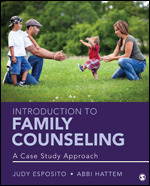Introduction to Family Counseling
A Case Study Approach
- Judy Esposito - Elon University, North Carolina, USA
- Abbi Hattem - Private Practice, Chapel Hill, North Carolina
- Lakitta D. Johnson, Jackson State University
Introduction to Family Counseling: A Case Study Approach presents basic knowledge about family counseling and applies various theoretical models to a case example looking at one nuclear family, along with its extended family members, that readers follow throughout the text. Judy Esposito and Abbi Hattem’s multi-generational family is constructed from their experiences as professors and family therapists to exemplify the concepts and theories of family counseling. Beyond the theories of family counseling, students learn about the family life cycle and various tools for assessing families as well as the history of family counseling. Ethical issues relevant to family counseling are also included along with transcripts from hypothetical family counseling sessions throughout the book. In addition, the book focuses on working with diverse families and takes special care to emphasize multicultural issues.
"Working with Families: A Case Study Approach offers a much needed approach to engaging students in the process of understanding and helping families. By using a multi-generational family case study, the authors open a window into working with families."
“Engaging, Creative, and Practical”
“You get a first-hand experience of being a family counselor as you undergo the experiential process of learning terms, skills, and concerns as you work with a family throughout this text.”
“Students will enjoy learning family systems from this engaging and comprehensive text.”
“[Working with Families: A Case Study Approach] is extremely thorough and provides many thought provoking exercise and activities that can be used in the classroom.”
I adopted this text for the case study format. It was well received by the students. One downfall is the lack of substantial theory in the text. However, that can be added by the instructor. Overall, a nice text.

